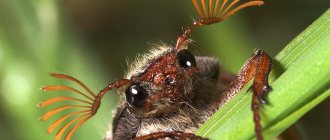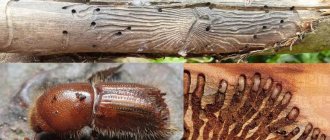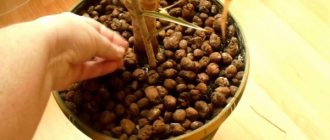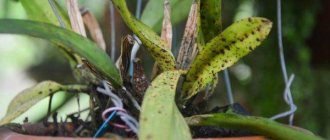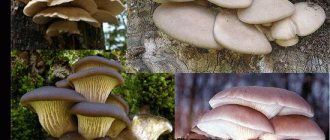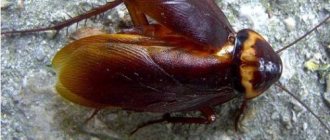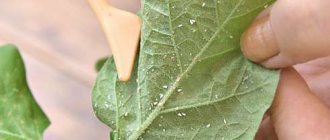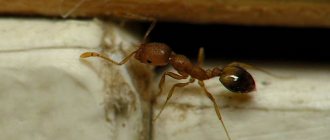A person who breeds indoor plants must be prepared for the fact that his pets may be attacked
various insect pests of plants. Control methods include creating optimal conditions for removing pests, chemicals and traditional methods.
Therefore, information about these enemies of flowers
it is absolutely necessary to identify its type in time and respond with suitable control measures.
In addition, it is important to follow measures to protect plants from pests and early diagnosis. After all, the sooner a pest is detected, the easier it is to get rid of it
.
This requires regular inspection of plants.
to assess its condition by appearance. If insects are found, a number of measures should be taken that are common to all types of pests:
- immediately place the infected plant in quarantine
, protecting it from other flowers,
wipe the plant
with a sponge or rag soaked in an alcohol or soap solution, trying to remove most of the insects; - get rid of all affected parts
of the plant; - very carefully examine
all other indoor flowers for the presence of pests; - When using chemicals against pests, use protective equipment
(rubber gloves, mask, etc.), ventilate the room after treatment.
Shchitovka
Scale insects can be seen visually - as small brownish tubercles. This is their protective shell, under which pests hide. Size – about 2-4 mm. Scale insects multiply quickly, spread throughout the plant, and gradually the flower withers, becomes covered with fungus and dries out.
The first step is to remove as many parasites from the plant as possible by hand. This is convenient to do with cotton pads, sticks and a soft toothbrush. Then rinse the flower under a hot shower, about 40-45 degrees. A solution of grated laundry soap is suitable for spraying. And we strongly recommend treating flowerpots with a professional insecticide.
Preventing pest contamination of soil in a flower pot
To prevent this problem from occurring, the following recommendations must be followed:
- do not allow the soil to become waterlogged or dry out;
- regularly remove dead parts of plants;
- periodically loosen the ground;
- observe a 7-day quarantine for new plants;
- do not use land from your personal plot;
- before using purchased soil, disinfect it;
- monitor the level of natural light, temperature and humidity in the room where the green inhabitants of the home are located;
- periodically inspect the plants and the soil in which they grow to identify pests - the presence of some harmful insects is indicated by slower growth of the plant, fading, and new growths on the leaves.
Source
Spider mite
The tick itself is almost impossible to notice, but its thin silvery web is clearly visible. Gradually the plant withers, weakens, its immunity drops, and then a fungus appears. It is difficult to completely get rid of a tick, so you need to act radically.
Remove the most damaged areas and wash the plant in a warm shower with shampoo or dish soap. Then treat with a strong infusion of chamomile, basil or pyrethrum. To spray, dissolve a few drops of tea tree oil in water. To water the soil, it is better to take chemicals.
The most unpretentious indoor plants: photos and names (catalog)
Aphid
In fact, this pest does not often settle in homes. Although aphids are small, they are quite easy to notice because the colonies cover areas of the plant too densely. Dark spots remain at the bite sites, and the aphid also leaves a sticky reddish liquid behind it.
There is good news - a regular shower with strong pressure works great against aphids. And for prevention, strong odors are enough - citrus peels or blooming geraniums. To spray a damaged plant, use a solution of laundry soap or an infusion of 4 tablespoons. zest per liter of water.
Withering plant. Damaged root system.
Springtails, or springtails
Signs: Wilting plant. There are neat piles of earth on the surface of the earth. Insects are clearly visible under the pot in the tray and on the surface of the soil. Features of the pest: Very mobile jumping insects from 1 to 4 millimeters of various colors (from light to black). Depending on the species, they live in the ground or on the surface of the soil. They usually do not cause significant harm to the plant. Method of control: It is necessary to dry the soil in a flower pot. Add a layer of sand on top. In case of severe infection, immerse the pot in water, collect the floating insects, and treat the surface with insecticides. Dry the ground.
Earthworms
Signs: Causeless wilting, depressed appearance of the plant. There are characteristic piles of earth on the pallet. Features of the pest: Large worms that feed on plant debris. When there is a shortage of food, they switch to underground shoots and roots. Method of control: Watering is carried out with a weak pale pink solution of potassium permanganate. The crawling worms are collected. You can put the pot in hot water (50 degrees) and hold it for 15 minutes. When taking the plant outside, place the pots higher so that the worms cannot get in. Sterilization of garden and forest soil will help destroy worm eggs.
Sciarides
Signs: Plants wither and wither. Young roots are damaged. Features of the pest: Also called fungus gnats. These are dark-colored midges, 3-4 millimeters in size, with long mustaches. They hatch from white larvae with a black head and approximately 4 mm in length. The mosquitoes themselves are not dangerous. And their larvae eat biological remains and young roots. Method of control: An aerosol is used against adult individuals to kill flying insects or collected with a vacuum cleaner. To kill the larvae, Bazudin and Grom-2 are used. A 0.5 cm layer of sand is poured onto the surface of the earth.
centipedes
Signs: Plants wither and wither. Damaged root system. Features of the pest: They live in compost heaps, consuming organic residues. When starved of food in a flower pot, insects can feed on plant roots. Method of control: Use the manual method of collecting centipedes.
Mealybug
This is another houseplant pest that is very easy to identify. Scale insects look like small white bugs, as if sprinkled with flour or starch. They hide on the back of the leaf blades and leave behind a whitish coating. The scale insect provokes the fungus and sucks the juices out of the plant.
In most cases, to combat mealybugs, it is enough to remove the parasites with a cotton pad soaked in alcohol and spray the flower with an alcohol or tobacco solution several times at intervals. In more difficult cases, it is better to use insecticides. If the roots are affected, you will have to completely remove the plant from the pot, wash it thoroughly along with the roots, treat it with drugs and replant it in a new disinfected substrate.
How to get rid of white bugs in the soil of indoor plants
Professional preparations and folk remedies are used to control pests. The choice depends on the individual preferences of the grower and the number of parasites.
- Aktara. Universal insecto-acaricidal agent. Destroys adult individuals, imago. White bugs die within 30 minutes. The product continues to act for another 20 days, preventing re-infection. Does not harm the plant, helps to recover. 4 g of the drug is enough for 5 liters of cold water. Spraying is carried out in a well-ventilated area or outside.
- Actellik. Broad-spectrum insecticide. Destroys pests in 20 minutes and continues to work for another 20 days. Sold in ampoules of 2 ml, designed for 5 liters of water. The solution is prepared immediately before use. Plants are sprayed outdoors. The drug is toxic and requires strict adherence to the instructions.
- Inta-Vir. An insecticidal preparation for treating any plants in open or closed ground. The tablet dissolves in 10 liters of water. Spray the flowers in a well-ventilated area. Does not affect vegetation, helps restore strength.
Preparations against pests
If bugs appear in indoor flowers, you need to reconsider the care conditions. Pests reproduce in high humidity or do not tolerate water. Initially, you should understand the type of parasite, then take action. Sometimes it is enough to simply dry the soil or spray the flower with cold water to make the parasites disappear.
- Soap. If there are white bugs in a flower pot, the plant is sprayed with a concentrated soap solution. Use laundry, tar, and green soap. Repeat the procedure after 2 days. Pests disappear completely within 14 days.
- Manganese. Dissolve potassium permanganate in water until it turns pink and water the soil. A powerful antibacterial agent will destroy all small parasites. The same action must be performed when replanting plants to disinfest the soil.
- Orange zest. Cut off the peel, pour alcohol, leave for a day. Spray the soil and plant. If you don’t have time to prepare a folk remedy from orange, you can use vodka.
To prevent the appearance of white bugs, it is necessary to use special soil, disinfect the soil, follow watering rules, and place a mosquito net on the windows.
Nematodes
Nematodes are especially dangerous for flowering plants, ferns and ficus. Roots hide in the soil and cause growths and growths on the roots of the plant. Leaf and stem ones leave the same growths and lead to deformation of leaves and shoots.
The plant looks strange, develops strangely, and some areas turn pale, turn brown and die. In general, fighting nematodes is pointless and ineffective, so we recommend getting rid of the infected flower before the parasites spread further.
Indoor plants: photos and names (catalog)
Holes on the leaves
Caterpillars
Signs: Eaten holes in leaves, damaged young shoots. Features of the pest: At night, the caterpillar crawls out and eats leaves and shoots. During the day it hides under the leaves and in the ovaries of flowers. Method of control: The manual method of collecting caterpillars is used. If the plant is exposed to the street, it can be sprayed with insecticides for prevention.
Earwig
Signs: Holes are observed on the leaves. The complete disappearance of leaf tissue is possible. Features of the pest: Dark brown with 2 mite appendages. At night it eats leaves and hides during the day. Method of control: Insects are collected by hand.
Mining fly
Signs: Something similar to paths or passages is observed on the leaves. Features of the pest: Damage occurs mainly in the open air. The larvae of leaf miners gnaw tunnels under the skin of leaves. Method of control: Pluck and destroy affected leaves.
Snails, slugs
Signs: Chewed leaves, shiny mucus. Features of the pest: Snails and slugs usually do not live in indoor conditions, as they require moist air. But in a greenhouse, plants can be damaged. They feed mainly at night. During the day they hide in a damp place. Method of control: Collected by hand. You can spray granular metaldehyde or mesurol over the soil surface.
Centipedes
Symptoms: Consolidated basal stems and lower leaves. Features of the pest: These insects are dark brown or whitish in color and resemble caterpillars. They harm plants placed in the garden in the summer. Method of control: The soil in the pot should be dried and sprinkled with a layer of sand, you can use ash. Since centipedes love moisture, you can make a trap for them. A small board is placed next to the plant, under which insects will subsequently gather. Now they can be collected.
Grape elephant or weevil
Signs: Nibbled edges of leaves. Withering and drooping plant. Features of the pest: Both beetles and larvae cause damage. The beetles chew off the edges of the leaves. The larvae are cream-colored (up to 2.5 cm), live in the ground, feed on roots, bulbs and tubers. Method of control: If bugs appear on the leaves, you need to water with a systemic insecticide and also treat the leaves.
Thrips
Thrips look like small oblong sticks, and adults can fly. They prefer young shoots of flowering plants because they cannot break through the too thick skin. The puncture sites of the sucking parasite remain yellowish dots. Gradually, you can notice the products of their vital activity.
To make the fight against thrips meaningful, you will first have to cut off all the flowers and buds. It is helpful to treat the leaves with a solution of anti-flea and tick shampoo for pets. You need to apply foam to the ground part of the flower and wash it off after half an hour. Complex insecticides work great.
Plant pests
Insects are one of the most ancient, numerous and diverse groups of animals on Earth - more than a million species, distributed everywhere and play a huge role in the biological cycle of substances, soil formation and plant pollination. Many types of insects are pests of ornamental and agricultural crops. PESTS OF PLANT ROOT SYSTEMS
May beetles are particularly dangerous and widespread pests of tree species. These beetles measure 17–31 mm. In Russia there are 9 species of May beetle, the most harmful is the Eastern May beetle (Melolontha hippocastani). In May, emerging from the soil, the beetles rush into the crowns of trees for additional nutrition. The leaves of oak and birch are most damaged by beetles. apple trees, poplars. and you. 6 - 8 weeks after the start of flight, larvae appear. Further development of the larvae occurs in the soil, and they first feed on thin roots and humus, and then switch to feeding on thicker roots, bulbs and root crops. In damaged plants, the water regime is disrupted, they do not receive normal nutrition and, depending on the degree of damage, may die.
Control measures: compliance with agrotechnical requirements for growing each crop; attract birds to your gardens - one pair of starlings, while feeding their chicks, brings them up to 8,000 cockchafers and their larvae; if beetles appear en masse, shake them off onto a cloth spread under a tree and destroy them; in the fight against larvae - the use of biological preparations based on nematodes “Nemabakt” and “Antonem - F”; treating the garden with insecticides (Decis, Actellik).
Mole cricket is a large (up to 50 mm) insect that leads an underground lifestyle. The most common mole cricket (Gryllotalpa gryllotalpa). The mole cricket is found mainly in damp low places, loose soils rich in organic matter, along the borders of waterlogged areas, especially loves manured soil, moves at shallow depths, makes nests at a depth of 10 - 15 cm, winter burrows reach a depth of 50 - 100 cm. The pest damages underground parts of various plants (root crops, roots).
Control measures: attracting birds to gardens; use of poisoned baits; treatment of the roots of seedlings before planting in the ground with a suspension of the drug "Aktara"
SUCKING PESTS OF PLANTS
WHITEFLY (Aleyrodidae) is a small flying insect (body length 1 - 2 mm) a bit like a miniature white moth, whose wings are covered with a waxy coating similar to flour. Plants are damaged primarily by whitefly larvae, which suck the juice from the leaves, preferring young foliage. When severely damaged, they colonize all parts of the plant. Of greater danger are the sugary secretions of the larvae, which create ideal conditions for the life of a sooty fungus that clogs the stomata of the leaf and closes it from light. The leaves gradually curl and fall off. As the larvae grow, they become covered with a waxy coating and become inaccessible to the action of chemicals.
Control measures: use yellow glue traps to catch adults; two - three times spraying with solutions of insecticides (actellik, kinmiks, karbofos).
Aphids (Aphidoidea) are small insects, the size of which does not exceed a few millimeters. About 4,000 species of aphids are known. All aphids feed on plant juices; many are capable of spreading plant diseases in the form of viruses and causing various abnormalities in plants, such as galls. Insects are clearly visible to the naked eye, and aphid infestation is also indicated by deformed shoot tips, curled leaves, and sweet discharge (honeydew) on leaves and shoots. Subsequently, sooty fungus and ants appear on these secretions. In affected plants, the leaves curl and turn yellow, the buds do not develop or produce ugly flowers.
Control measures: in case of minor damage, you can spray with infusions of tobacco, celandine, onions, onion peels, and dandelion; in case of severe infestation - chemical methods of control using insecticides (actellik, actara, decis, fitoverm).
SALIVARY FOAM (Philaenus spumarius) is an insect up to 10 mm long, from light yellow to brown. Adults and larvae feed on plant juices. The larvae are white, greenish-yellow when older, and are found in a foamy, saliva-like liquid. which protects them from drying out. Damaged leaves are deformed and wrinkled.
Control measures: spraying plants with one of the drugs - actellik, inta-vir, fitoverm, fufan, actara.
FAMILY HERMES (Adelgidae) is a large group of aphids that develop on conifers. This is an insect with a dark brown color, with waxy fibers similar to white fluff on the sides, and in adults throughout the body. Hermes lives in colonies and settles on the needles and shoots of plants, forming a white fluffy coating. By sucking out the juices, pests inhibit and weaken plants, retard their growth, cause bending, wrinkling, twisting of damaged shoots and needles, tissue proliferation and the formation of galls, growths, and nodules.
Control measures: double treatment with systemic insecticides (actara, fufanon, confidor, etc.).
COCCIDAS (Coccoidea) are small insects (body length 1 - 7 mm), characterized by a unique body structure. They include 7 families, but most of the coccid species that damage tree species belong to 3 families: scale insects, false scale insects and mealybugs. Coccids are perhaps the most dangerous pests found in our gardens. They are inconspicuous, difficult to distinguish, spread easily, and are protected from external influences, including chemical control agents.
SCALE (Diaspidida) - got its name from the round or elongated shield that covers the pest. The shield is formed from the skins remaining after the molting of the larvae, as well as wax and other secretions of the skin glands. Such a shield is not an integral part of the body and is therefore easily separated. Scale insects have several types, differing in size (0.5 - 5 mm) and color (from white - gray to brown). This is a fast-growing pest. At the initial stage of development, scale insects are very mobile and can quickly spread throughout the plant and infect neighboring ones. Adult females are motionless, males are much smaller than females, have one pair of wings and normally developed limbs. Damaged plants turn yellow, develop incorrectly, leaves fall off, and young shoots dry out.
FALSE SCALE (Lecaniidae) is an insect 3-7 mm in size that does not have a scutellum, but the upper surface of their body is highly chitinized, hard and resembles a scutellum in appearance. It affects many deciduous trees (white acacia, maple, ash, poplar, hazel, etc.). By sucking juice from leaves and shoots, the false scale insect secretes a large amount of honeydew, on which sooty fungi develop, covering the leaves and branches with a black coating, making it difficult for plants to breathe and feed. Damaged plants weaken, their productivity and frost resistance decrease, and severely damaged trees may die.
Mealybug (Pseudococcidae) is a white insect up to 5 mm in size, the entire body of which is covered with waxy secretions in the form of a mealy coating. The pest moves well at almost any age. It gathers in colonies, mainly along the veins on the underside of leaves, in the axils of leaves, on petioles and stems, where it forms white cotton-like secretions in which females lay eggs. The female is wingless, elongated-oval, with projections and long setae along the edges. males have wings, normally developed limbs, an abdomen with two tail filaments or a bunch of them. Plants are damaged primarily by larvae, which suck the juice out of it and at the same time inject toxic substances that slow down the growth and development of the plant. Damaged plants have deformed flowers, buds and leaves.
Control measures: double treatment with insecticide solutions (actara, decis, karbofos, etc.); as a preventive measure, garden care, removal of old branches that thicken the crown; When purchasing, carefully inspect the plants to detect pests.
PLATES or PSYLLIDAS (psyllidae) are small insects 1.5 - 4.0 mm in size, with piercing-sucking mouthparts. Adult copperheads have two pairs of roof-shaped wings and hopping hind legs. Larvae and nymphs of honeydews feed on the underside of leaves, petioles, pedicels and shoots. Traces of their damage are numerous light spots, often grouped on the periphery of the leaf blade. The pest damages many species: apple tree. pear, lilac, linden, birch, etc. By sucking juices from plants, copperheads cause drying of leaves and shoots, falling off of buds, flowers, ovaries, slowing down plant growth, and contaminate leaves and buds with honeydew. Adult insects overwinter in cracks in tree bark and under fallen leaves.
Control measures: treatment of affected plants with a solution of decis, karbofos, etc.; regular garden care.
SPIDER MITES (Tetranychidae) are very small pests from the class of arachnids, ranging in size from 0.3 to 1.0 mm. The body of the pest is round, from yellowish to bright orange or red. They are found both on deciduous trees. and on coniferous woody plants, they harm herbaceous plants, plants in greenhouses and greenhouses, and indoor flowers, producing several generations a year. At first, spider mites settle mainly on the underside of the leaves, then they appear on the top, weave a thin web and lay eggs. Damaged leaves and needles turn brown and dry out, and the buds often do not open.
Control measures: spraying plants with one of the drugs: Actellik, colloidal sulfur, Fitoverm, Fufanon.
CHEATING PESTS OF PLANTS
Weevils (Skosari or Elephants) (Curculionidae) are a large family of herbivorous beetles, a characteristic feature of which is the elongated front part of the head - the rostrum, which is why they received their Russian names.
RASPBERRY-STARWBERRY WEEEL (Anthonomus rubi) is a beetle 2.5 - 3.0 mm long, black in color, sometimes with a brown tint, covered with thick light gray hairs. The pest damages strawberries, raspberries, roses, as well as herbaceous plants from the Rosaceae family. They feed on plant leaves, eating deep holes and small through holes in them. Females lay eggs in the buds and gnaw the peduncle, causing the bud to break and fall off. young beetles emerge in mid-summer and feed on leaves until autumn. Beetles overwinter under fallen raspberry and strawberry leaves. With a large number of pests, the yield of berry crops and flowering of shrubs decreases.
ELEPHANT - BOOKARK (Coenorrhinus pauxilus) seriously damages fruit trees. The beetle is about 3.0 mm long, dark blue with a greenish tint, and overwinters in the soil around the tree trunks. In the spring, with the onset of warmth, the beetles come to the surface and fly up into the trees. They gnaw through the buds of apple, pear, cherry, viburnum, euonymus, etc. By attacking very young buds, they can destroy the entire shoot. In May, the female lays eggs, for which she makes a hole on the underside of the median nerve of a young leaf and lays an egg in this hole - one on each leaf. Then it moves to the petiole of the leaf, makes one or two punctures on it, as a result of which the leaf bends, dries out and falls off.
GREEK ELEPHANT (Rhynchitsbacchus) - harms apple, pear, cherry, plum, peach and apricot trees. The beetle reaches 4-7 mm, the body is shiny, copper-red, the head-tube, antennae and legs are purple. Pests appear in early spring and first feed on the buds, then eat the buds and pulp of the leaves. Females lay eggs in fruits that are beginning to form. To do this, she gnaws out a small chamber in the pulp of the fruit, places an egg there and covers the hole with excrement and gnaws the stalk. At the same time, fungi are introduced into the wound, causing fruit rot. Otherwise, the elephant larva does not develop. Damaged fruits rot and fall to the ground.
PINSODESNOTATUUS (pissodesnotatus) is a small pine weevil that damages pine, as well as larch fir. The beetle is 5 - 7 mm long, the body is dark brown with two bands on the elytra. The beetles feed on the tops and branches of young pines, plunging the rostrum deep into the bark, while resin flows out of the wound and forms a shiny dot on the bark. Eggs are laid in depressions gnawed out in the lower part of the trunks and at the root collar of young weakened pines. The larvae gnaw tunnels under the bark and overwinter under the bark (beetles or larvae). In the spring, they gnaw a hole through which it flies out. The pest is most dangerous for young (4 - 15 year old) pine crops and can cause them to dry out.
APPLE FLOWER BEETLE (Anthonomusponorum) is a beetle with a body length of 3.5-4.5 mm, brownish-brown in color. The beetles overwinter in cracks in the bark, in the soil under fallen leaves, come to the surface in the spring and begin to feed on the buds of apple, pear, and less often hawthorn, gnawing deep holes in them. The female lays eggs in the buds. In years when the number of beetles is very large, they begin to feed on the leaves of rose hips and roses, skeletonizing them in the same way as the leaves of an apple tree.
Control measures: regular garden care, shaking off and destroying beetles, spraying plants with a solution of one of the drugs: Decis, Inta-Vir, Actellik, Fufanon, etc.
Armored mites
These pests are most familiar to orchid lovers, and they look similar to the regular small brown mites that hop around the stems and leaves of the plant. In reality, they are practically not dangerous for flowers, but they can carry the larvae of other pests, and in general they are not very pleasant. For control, we recommend using special acaricides, because ticks are very tenacious and adapt well to anything.
Whitefly
Externally, whiteflies resemble small moths, so they are quite easy to spot. They leave sticky trails behind them and drink the juices from the plant. In addition, this sticky mass clogs the pores and prevents the flowers from breathing, which is why they die quite quickly.
Whiteflies are tenacious, so you need to fight them systematically. First, wash the plant with soapy water or special green soap. Then treat with insecticides, several times at intervals. And if it doesn’t help, then alternate between different drugs. But with prevention everything is simpler: enough ash, fumigators and even banal glue traps.
Indoor flowers: photos and names (catalog)
Sciarides
The problem with sciarids is that they are also difficult to fight because they grow in the soil. And the advantage is that they rarely appear on indoor plants. The insects themselves resemble mosquitoes and are harmless to flowers, but they lay colonies of eggs, but the larvae then stick to the roots. A sure sign of the appearance of sciarids is the presence of small black midges in the room for no reason.
It is better to completely replace the affected soil by first washing the roots of the plant with warm water and treating it with preparations. And for prevention, the main thing is not to overwater the flowers and not to use organic fertilizers, such as drunken tea or potato peels.
Control measures
How to get rid of pests? This question haunts many indoor plant lovers. Pest control can be done in a variety of ways. For example:
- Mechanical.
- With the help of biological drugs.
- Using chemical control agents.
- Based on folk recipes.
Pests of indoor plants and their control, plant protection, how to get rid of them
Mechanical method
This is an environmentally friendly, simple and affordable way to combat parasites on your own. To do this, you need to take a tool, preferably disinfected, and cut off the damaged parts of the plants. It is better to treat the cut areas with activated carbon. Pests that can be seen with the naked eye can be picked out with your hands without any problems, unless there are so many plants and pests.
Interesting recipe! A contrast shower will help rid indoor plants of parasites. It is enough to spray the flower with water and then wipe the leaves with a cotton swab and the problem can be solved.
Folk remedies
To protect them from various insects, as well as in cases of their diseases, many lovers of indoor plants prefer folk remedies. These products have been tested for many decades, so there is no doubt about their effectiveness. Decoctions prepared from plants such as chamomile, nettle, yarrow, dandelion or marigold are absolutely harmless to humans and plants. Solutions prepared with garlic and onions have the same effect. The prepared solutions are simply sprayed on the plants almost every day.
As an option, you can use citrus peels, which should simply be buried in the ground. The smell of these components cannot be tolerated by many parasites that want to settle on indoor plants.
Solutions based on wood ash, furatsillin, soda or potassium permanganate work no less effectively in this direction. You just need to prepare the solution correctly, after which the plants are sprayed with a spray bottle.
It is important to know! If you add a little soap, preferably laundry soap, to the solutions, the product will not drain from the leaves so quickly, which will enhance the effect of using the product.
Biological method
Biological preparations differ in that they act only on certain types of pests and are safe for humans and pets. Despite this, the working composition must be prepared correctly and used correctly. For example:
- The solution is prepared strictly according to the instructions.
- After treatment, the plant should dry.
- The room needs to be well ventilated.
For such purposes, you can use control agents such as Agrovertin, Fitoverm or Iskra-Bio.
Root mites
This is the most dangerous group of ticks because they are almost impossible to notice. Most often they settle on bulbous plants, gnaw the bulbs and lay eggs in them. Externally, these are tiny translucent insects that are difficult to see without magnification. Indirect signs are rotten bulbs with suspicious spots.
It is usually pointless to fight an overgrown colony, because the roots are already affected. So it is important to prevent this situation from happening. Always carefully inspect all bulbs before planting and soak any suspicious ones in special acaricides.
Soil insects
These include springtails, springtails and springtails. These are small brown spiders, whitish fleas or gray worms that periodically appear in the soil or pan after watering. All of them are completely harmless, and this is just an indicator that the soil is rich in organic matter. Most often, such insects enter an apartment with garden soil. Usually, for control and prevention, it is enough to establish care and watering regime.
Did you like the post? Subscribe to our channel in Yandex.Zen, it really helps us in our development!

